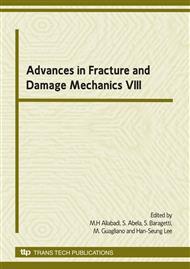p.145
p.149
p.153
p.157
p.161
p.165
p.169
p.173
p.177
Effect of Water Absorption on Mechanical Properties of Hemp Fiber Reinforced Composite
Abstract:
In this study, the effect of water absorption on mechanical properties of hemp fiber reinforced green composite(HGC) was examined. Plain woven hemp fabric was used as reinforcement. Emulsion type biodegradable resin was used as matrix. The composite was made by compression molding method. Water absorption rate and the effect of the ratio on the mechanical properties were examined. Following results are obtained. The water absorption rate increased with an increase of absorption time. The water absorption rate had an equilibrium state within 30 days. The duration was not dependent on fiber content. In the case of that specimen was kept in water 182 days, the strength decreased 70% of the ultimate one. But in the case that the specimen has dry process after water absorption process, the strength recovered 57%. The recovery ratio is not dependent on water absorption time. The strength reduction rate after dry process is not dependent on fiber content. The strength of resin decreased 62%, and the strength of fiber decreased 13% by water absorption. So the strength reduction of the composite is due to the effect of matrix.
Info:
Periodical:
Pages:
161-164
Citation:
Online since:
October 2009
Authors:
Price:
Сopyright:
© 2010 Trans Tech Publications Ltd. All Rights Reserved
Share:
Citation:


